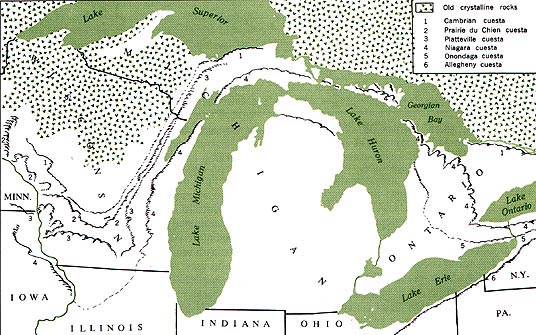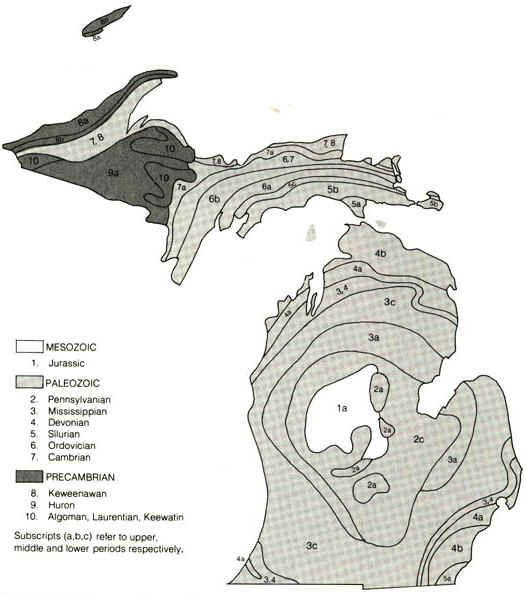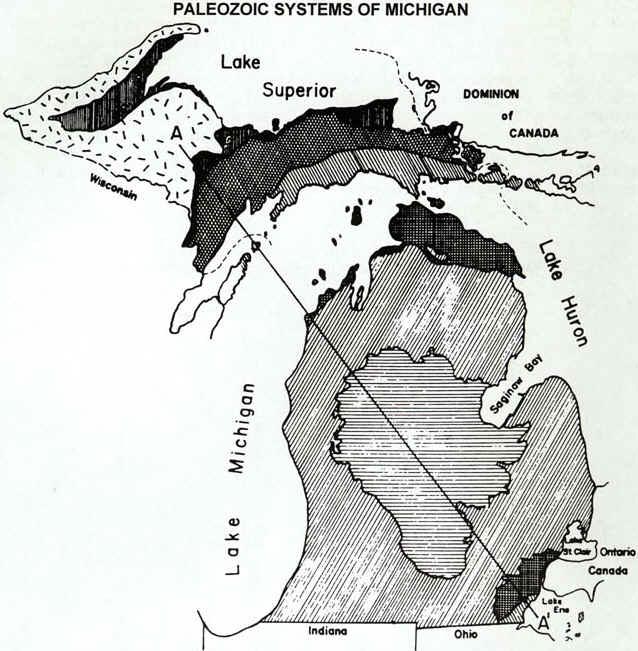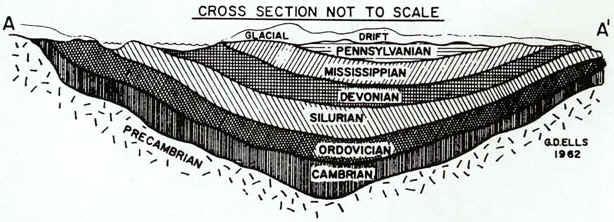THE PALEOZOIC ERA
Paleozoic ("Ancient Life") Era. This is the first of three geologic eras
squeezed into the last 10% of the Earth's whole geologic history. But things are really
starting to happen! This last 10% of Earth's history is called the "Phanerozoic
Eon" or eon of "evident life." This means that rocks from the Phanerozoic
contain fossils, lots of fossils!
The Paleozoic period lasted about 325 million years, from about 570
million years ago to about 245 million years ago. So much happened during the Paleozoic
that it is divided into seven geologic time periods, shown on the red steps of the
"Staircase of Time". Many different things happened during each period, but we
can only give a summary here. You can learn more by going to your library or searching the
Internet for words like "Paleozoic" or the names of each of the periods.
Here in the Paleozoic, the Earth's interior has cooled down to
something like modern levels, so that volcanic activity is usually about as humanity
experiences it: a few minor eruptions like Mount St. Helens each year, and major ones like
Krakatoa every century or so. However, gigantic "hot-spot" type eruptions still
occur every hundred million years or so. Plate tectonics continues to push land masses
across the Earth's surface. At this particular time - the middle of the Silurian Period -
most of the land is still locked in two supercontinents called Gondwanaland, which happens
to be wandering over the South Pole in our view, and Laurasia, on the other side of the
globe. Huge glaciers cover the interior of Gondwanaland, and the Earth is experiencing one
of its ice ages. Over the next hundred million years, Gondwanaland will move north over
the equator and begin to break up, and the climate will warm up substantially.
The composition of the atmosphere has continued to change slowly,
mostly due to the increase of oxygen produced by plants. By the Paleozoic, the composition
of the air has reached something like what we breathe now: about 4/5 nitrogen, 1/5 oxygen,
and small amounts of carbon dioxide, water vapor, and other gases. At long last the air is
capable of supporting large animals. And almost in response, life explodes into the
Paleozoic!
At the beginning of the Paleozoic, life existed only in or near the
ocean. Trilobites, shellfish, corals, and sponges appeared, followed by the first fish.
Land plants appeared near the end of the Ordovician and for the first time we see the
green of land plants in our global view. Huge forests and swamplands formed during the
warm climate of the Mississippian and Pennsylvanian periods that later fossilized into the
giant coal beds of the eastern United States. Animal life also moved onto the land, first
the arthropods (spiders and insects to you), then the amphibians, and later the reptiles.
The most abundant animals on land and sea during the Paleozoic were those like shellfish
and insects that lacked backbones, so the Paleozoic is often called "The Age of
Invertebrates."
The Paleozoic was also marked by several mass extinctions: geologically
short periods of time during which large numbers of life forms died out. Mass extinctions
occurred at the end of the Ordovician, the Devonian, and the worst one of all at the end
of the Permian, when about 95% of all life on Earth died! These mass dyings were probably
caused by climate changes and
periods of giant volcanic eruptions.
We can follow the development of life in detail during the Paleozoic,
because at the beginning of that Era, life forms developed hard parts like shells, teeth,
bones, and woody parts that were easily preserved as fossils. Earlier life forms were
single-celled and soft-bodied, so older rocks contain few fossils. During the Paleozoic
Era, beginning about 600 million years ago and ending about 230 million years ago,
seawater invaded the Michigan Basin at least ten times. The cause for these repeated
oscillations of sea level and the development of a series of basins and domes on the
continent has, however, remained largely a mystery.
During the retreat and advance of the seas, many hundreds of meters of
sediments were laid down, which have long since turned to rocks and associated deposits
such as halite (rock salt), gypsum (calcium sulfate with water), liquid brines, petroleum,
lime, clay, sandstone and coal.
It all began during the Cambrian and Ordovician periods, when one
rather elongate basin extended from Missouri northeastward through Illinois and lower
Michigan. This basin was bounded on the northwest by the Wisconsin Arch and on the
southeast by the Cincinnati Arch. During the middle Silurian the Kankakee Arch developed
across northeastern Illinois, forming two separate basins. Although it did not form a land
barrier, it greatly restricted circulation of sea waters within the Michigan Basin.
The map below shows that there are many other major structural basins and domes in the
United States--of which the Michigan Basin is one of the more prominent. Arrows
pointing into basins imply that basins are areas of preferred deposition.
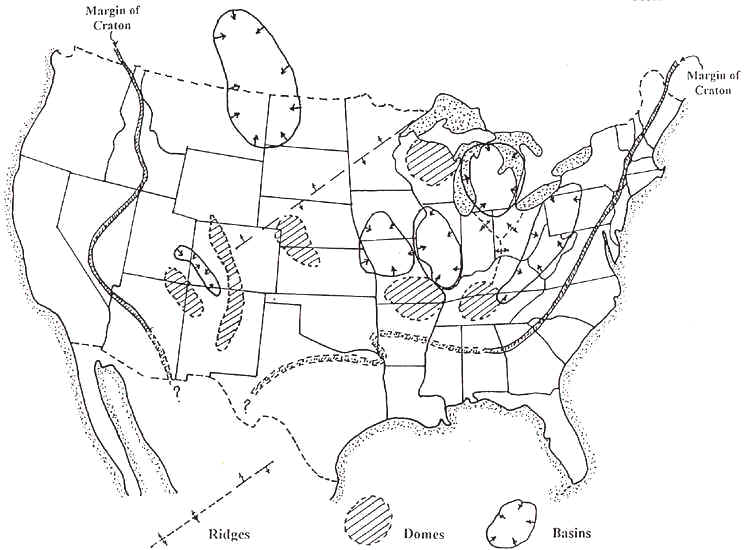
Source: Unknown
Here's a more detailed map (below) of the various structural faults, basins, arches and
domes in the Great Lakes region.
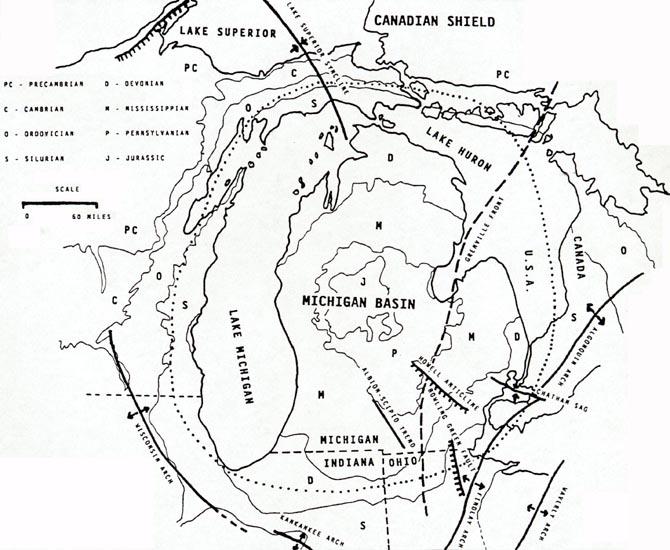
Source: Unknown
The rate of subsidence within the Michigan Basin eventually increased,
and a series of coral reefs developed along the Kankakee Arch and in the shallow waters
along the western and southern margins of the basin. Some of these reefs can be seen today
on the south side of Chicago, and I-94 crosses over a giant quarry into one of them.
Assuming that the Silurian reefs formed in an environment similar to modern reefs, we can
infer something about the Great Lakes area during this time: it was a tropical or
sub-tropical environment. Well-preserved fossils in most of these ancient reefs
substantiate this assumption. Outward from the reefs, in the deeper water, muds rich in
CaCO3 accumulated on the floor of the vast shallow seas, generally producing
thinly bedded dolomite that contains few fossils. Thus, visualize a subsiding, circular
basin in lower Michigan, surrounded by shallow waters and coral reefs.
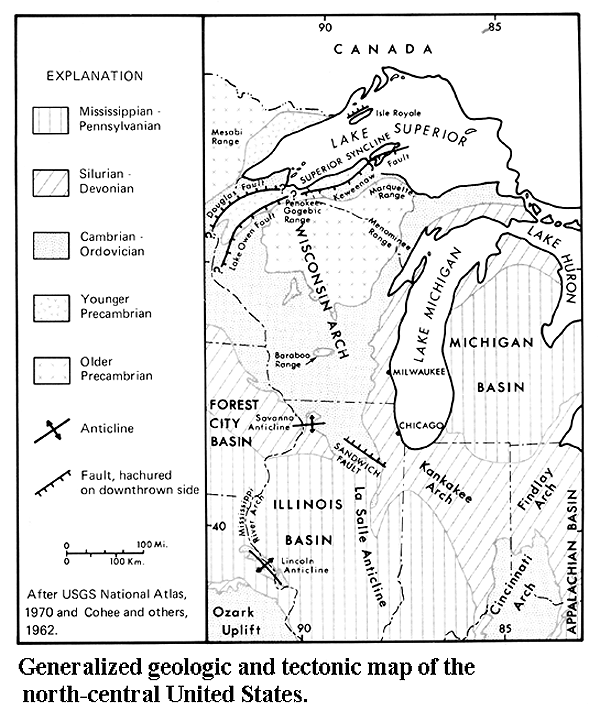
Source: Unknown
Source: Physical Geography of Wisconsin, Martin
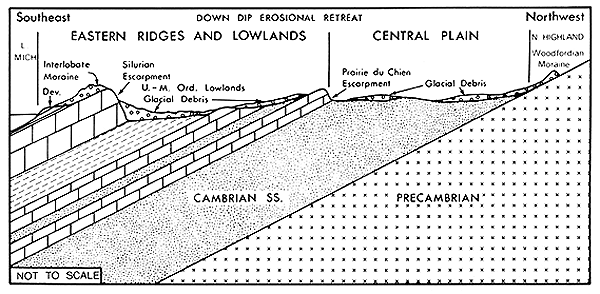
Source: Physical Geography of Wisconsin, Martin.
Transgression (the sea moving onto the land) and regression (the opposite) are
important concepts to know when discussing sedimentary rocks. Transgression and regression
were very important parts of the depositional environments of the Michigan basin during
the Paleozoic. During transgression, the rate of sea level rise is greater than the rate
of sediment supply, resulting in onlap of sediments ("a" below). Typically, we
then see rocks that change from sandstones to shales to limestones, as we move upward in
the rock column.
During regression, the rate of sediment supply exceeds the rate of sea level rise, or the sea level falls, causing offlap of sediments ("b" below). In this case, the rock column is (from bottom to top) limestone, shale, sandstone.
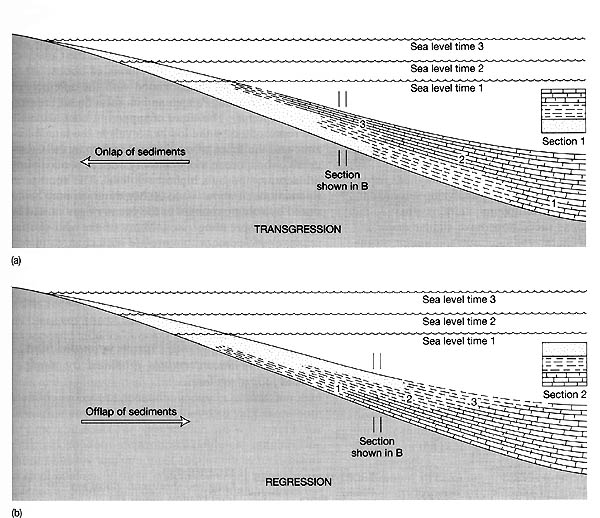
Source: Unknown
There is a marked contrast between the old, resistant Precambrian and Cambrian rocks of
the western half of the Upper Peninsula and the sedimentary rocks of the rest of Michigan
(see below).
Source: Unknown
Source: Unknown
The limestones, sandstones and shales, which dominate the Michigan Basin of the lower
peninsula, are approximately 500 million years old, some perhaps less. The sediments that
form these sedimentary rocks were deposited on the bottoms of ancient seas, and the rock
layers are piled on top of each other like saucers. The edges of the sedimentary rocks
appear at or near the surface in northern Michigan-for example, near the Straits of
Mackinac. In the center of the basin, they are about 14,000 ft (4,267 m) thick.
>
Source: Unknown
This material has been compiled for educational use only, and may not be reproduced without permission. One copy may be printed for personal use. Please contact Randall Schaetzl (soils@msu.edu) for more information or permissions.
